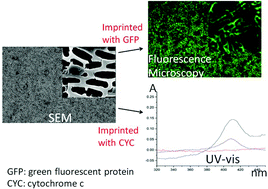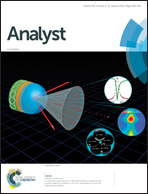Bacteria assisted protein imprinting in sol–gel derived films
Abstract
A hierarchical imprinting strategy was used to create protein imprints in a silicate film with a high binding capacity as well as selectivity toward the imprint protein and little specificity towards other proteins. In the first part of this work, rod-shaped bacteria were used as templates to create imprints in silica films of various thicknesses to open up the silica framework and increase the surface area exposed to solution. In the second part, the protein (e.g., cytochrome c (CYC) or green fluorescent protein (GFP)) was covalently attached to the surface of Bacillus subtilis and this protein-bacteria complex served as the imprint moiety. Atomic force microscopy and scanning electron microscopy were used to image the micron-size rod-shaped bacteria imprints formed on the silica surface. Fluorescence microscopy, which was used to follow the fabrication process with GFP as the representative protein, clearly demonstrated protein imprinting, protein removal and protein rebinding as well as protein specificity. Visible absorption spectroscopy using CYC as the imprint protein demonstrated relatively fast uptake kinetics and also good specificity against other proteins including bovine serum albumin (BSA), horseradish peroxidase (HRP), glucose oxidase (GOD), and lysozyme (LYZ). Collectively this work demonstrates a new surface bio-imprinting approach that generates recognition sites for proteins and provides a viable means to increase the binding capacity of such imprinted thin films.



 Please wait while we load your content...
Please wait while we load your content...